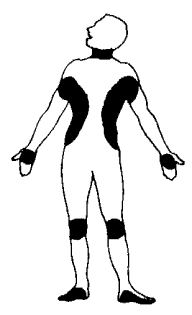 |
Science Frontiers ONLINE No. 126: Nov-Dec 1999 |
|
|
Knismesis And Gargalesis
This item is not as serious as its pretentious title. Everyone has experienced both of these ominous-sounding physiological conditions.
One can inflict knismesis upon one's self, but gargalesis requires someone else or perhaps a human-like robot (android) to perform the act.
All right, so knismesis and gargalesis are really only the two recognized kinds of tickling; but the latter form stimulates several interesting physiological conundrums.
First, let's separate the two conditions. Knismesis is very light stimulation of the skin, say by a feather. It rarely produces laughter and can be induced autonomously, by someone else, by a crawling insect, or even by mild electricity. Gargalesis cannot be selfinduced. It consists of heavier pressures applied to specific parts of the body, especially the ribs and arm pits. But the finger probing usually has to be done by someone else. Gargalesis is often very unpleasant but is nevertheless likely to be accompanied by smiles and laughter. In fact, gargalesis can be so disturbing that medieval torturers supposedly tickled some of their victims to death! (A variant of Chinese water torture?)
 Ticklish areas on the human body. |
Tickling becomes anomalous only with gargalesis. The questions are:
- Why does this kind of tickling elicit laughter when it is so unpleasant?
- Why cannot one tickle one's self this way? At least most people can't.
- Why does gargalesis exist? What survival value does it have? Is evolution just having fun with us?
C.R. Harris is a tickle researcher and has even designed a (fake) tickling machine to test her subjects. She believes she knows why we laugh when we are subjected to gargalesis.
"...the smiling and laughter encourage the tickler to continue. If tickling produced a negative facial expression, conspecifics would be far less likely to engage in it during playful bouts -- thus cutting off the development of combat skills that might have survival value."
Translation: tickling-plus-laughter promotes the roughhousing needed to develop combat skills. Chimps, deer, and most young mammals engage in similar sport for the same purpose; but, as far as we can tell, without the laughing.
The inability to self-tickle is hard to understand. After all, we can easily produce a knee-jerk reaction by tapping our own knee. Why can't we tickle our own ribs? Perhaps because our brain controls the action and also cancels out signals to pull away from the tickle and laugh. It could be the unpredictability of someone else's tickling that makes it so effective. Yet, when the tickler tickles our shoulder rather than our ribs, nothing happens. Strange!
Why would evolution have given humans highly specific ticklish areas that respond only to other people and, to boot, makes us laugh? What survival value is there in this? In the end, Harris has to admit that tickling may not be adaptive at all, but rather an almost-neutral side effect genetically linked to some different characteristic that is adaptive. Mother Nature's joke on us?
(Harris, Christine R.; "The Mystery of Ticklish Laughter," American Scientist, 87:344, 1999.)